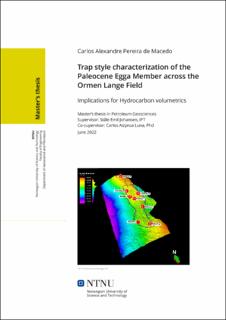| dc.description.abstract | The Ormen Lange field is one of the largest gas reservoir offshore mid-Norway, developed as a combined structural-stratigraphic trap. The reservoir type consists of deep marine deposits of excellent quality with a facies deterioration trend towards the fan fringe at its northern margin, coincident with the crest of the structure. Residual gas saturation at the apex of the structure and an overpressure aquifer has led previous authors to propose a hydrodynamic aquifer concept to explain the fluid distribution. However, previous works seem to discuss different observations separately, without direct integration.
Thus, this work focuses on integrating different results to better explain fluid distribution in the field. By looking into the details of each well's stratigraphy, this work further brings the subtle linkage between the underlying structural configuration and the observed reservoir distribution. Furthermore, such configuration may have controlled the facies distribution across the field, with an apparent increase in shale content to the north of the field. A higher shale content may have been prompted to develop polygonal faults through dewatering.
The analysis derived from this work suggests that polygonal faults baffle fluid flow and segment the field, while thin cemented sandstone layers limit the water column's vertical extent. Also, pressure in the field is related to the inflow of over-pressured water from dewatering underlaying smectite-rich shales. Given its origin, water inflow rates are relatively low and localized and do not sustain the premise of a hydrodynamic setting and a subsequent tilted contact. Instead, the polygonal faults serve as a baffle to fluid flow, which in addition to the decrease in pressure to the South, suggests an apparent tilted contact and, therefore, the proposal of a hydrodynamic setting. A hydrostatic setting, where stratigraphic and structural components shift the GWC across the field, is a more plausible concept to explain the fluid distribution. | |
